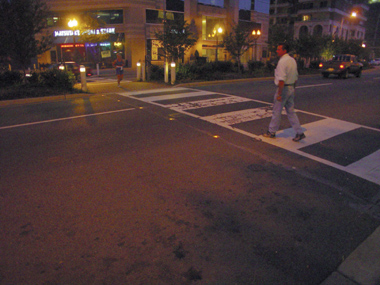Pleasantville Seeks Funding for Safety Crosswalk Pilot Program

Pleasantville may be the first municipality in Westchester to have two downtown street crossings with lights embedded in the pavement as part of a pilot program designed to enhance pedestrian safety at night.
The village’s Department of Public Works Superintendent Anthony Carr said funds could be allocated by the county to municipalities interested in lighted crosswalks.
The two crosswalks Carr recently proposed for the lights would be in front of the new building at 70 Memorial Plaza and stretch across the street to the gazebo, and between the Pleasantville Diner and the northern end of Memorial Plaza where a newly-configured parking area is planned after the slip lane funneling traffic onto Manville Road is removed. Those are two of the busier crossings in the village.
“I’m not aware of how much money is in the pot or what municipalities will be allocated, but we need to declare our intent to participate in the program,” Carr said at the Village Board’s Nov. 14 work session.
The pilot is officially known as the In-Pavement Lighted Crosswalks program. Carr said over the last two months members of the village’s Pedestrian Committee reached out to County Legislator Margaret Cunzio (C-Mount Pleasant).
Village Administrator Eric Morrissey said Cunzio suggested for Pleasantville to apply for the money through the discretionary funding as part of the county’s work on the 2023 budget. The budget is expected to be approved sometime next month.
“To my understanding there is no special county program for lit crosswalks,” Morrissey said. “The county gets a variety of different requests to fund projects and we are submitting a funding request for the lit crosswalks in Pleasantville through Cunzio’s office.”
According to Carr, the request does not require a grant funding application. What is required is a formal request supported by conceptual plans indicating specific locations where the lights could be installed.
Carr asked the board for its approval so he could move forward with the plans. During the regular board meeting that followed the work session, village trustees voted unanimously to give Carr the go-ahead to submit the required letter and plans to the county.
Promoting pedestrian safety, the in-roadway amber warning lights are embedded in the roadway to face oncoming traffic and warn approaching drivers that a pedestrian is in or near the marked crosswalk.
Based on quotes obtained from vendors for lighting the two proposed crosswalks, Carr estimated the total cost would be about $100,000. The money would come from the county with no outlay anticipated on the village’s part.
“It will be upwards of $80,000, but that doesn’t include labor costs,” he said. “If we do it in-house, we’d have to rent tools and special machinery. If we have a contractor do it, then we are subject to the minimal wage rates. But they are both good outcomes in the end.”
Carr said the two crosswalks that were proposed were chosen because they are in a high pedestrian-volume corridor.
“Both crosswalks are mid-block crossings and between two traffic signals,” he said. “Those two traffic signals are on Memorial Plaza and Bedford Road and on Memorial Plaza and Manville Road, and because there is parking on each side of the corridor – each side of the street – there is a blind spot for pedestrians who are crossing.”
Another criteria for the crosswalk near the diner is the upward slope of the road from Manville Road, which limits drivers’ visibility.
The crosswalk between 70 Memorial Plaza and the gazebo would have 10 embedded lights, with five lights on each side of the crosswalk stretching across the roadway. The installation would include a back-up battery system that would run off of energy from pole-mounted solar panels, a push button activation and signage.
The second proposed crosswalk near the diner would include 18 embedded lights with nine lights on each approach of the crosswalk. There would similarly be a back-up battery system, push button activation and signage.
Carr recommended the installation of solar-powered in-roadway lights with photocells that control lighting to turn on during evening hours and push button activation. In his memo to the board, he stated that village staff would observe the effects of the new system on motorists, operation and maintenance of the system, potential light pollution concerns and possible resistance to seasonal weather cycles, including whether any damage is caused by snow plows.
No date was mentioned about when the lighted crosswalks would be introduced. Carr estimated that the lights would take about three to five days to install.
Included in Carr’s documentation to the board was research showing a reduction in nighttime pedestrian accidents with the use of the lighting. In-roadway lighting gained popularity in the United States in the 1990s.

Abby is a seasoned journalist who has been covering news and feature stories in the region for decades. Since The Examiner’s launch in 2007, she has reported extensively on a broad range of community issues. Read more from Abby’s editor-author bio here. Read Abbys’s archived work here: https://www.theexaminernews.com/author/ab-lub2019/
